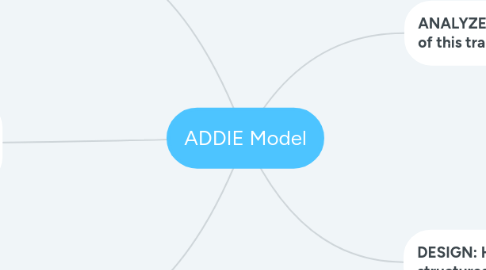
1. DEVELOP: What should the content of this training include, and how should it show up for effective learning?
1.1. Involve developers
1.1.1. Subject Matter Experts (SMEs) begin to build course content
1.1.2. Technical designers (where needed) to support in eLearning, coding, or other online aspects of course design (if needed)
1.2. Create learning tools and resources from the design and analyze phases' findings and research
1.3. Run tests of learning in order to validate its effectiveness and quality
1.3.1. Engage SMEs to provide review and provide feedback to enhance toward a training-ready version of the course
2. IMPLEMENT: How/Can we release this training to its audience?
2.1. Continue to run tests
2.1.1. Both SMEs as well as non-SMEs may be involved to review and share feedback at this time, in order to strengthen the course content, structure, and ensure it is at its highest quality for most effective learning
2.2. Provide necessary instruction to learners to engage with training content en masse
3. EVALUATE: Is this course the best it can be to meet its objectives?
3.1. Provide assessments to determine course quality, impact, and effectiveness, and what edits or updates need to be made
3.1.1. For Learners
3.1.1.1. SUMMATIVE: questions to test learning, may include yes/no or multiple choice answers and objective questions to test simple absorption of course content
3.1.2. For Training/Learning itself
3.1.2.1. FORMATIVE: may take place across the span of the course itself, including open-ended questions, requests for feedback, connecting Design-phase learning outcomes with Develop-phase tools
4. ANALYZE: What is/are the goal/s of this training?
4.1. Understand the landscape of the issue, project, or problem at hand
4.1.1. Define learning environment
4.1.1.1. Ask questions: about the issue, the behavior, the reasons behind the needs for the training, the anticipated learning environment, the audience, etc.
4.1.1.2. Incorporate knowledge of best practices into analysis of the learning environment
4.1.2. Learn from the past/prior attempts to solve this problem through research
4.1.2.1. Review existing data
4.1.3. Define learning objectives (on a broad level)
5. DESIGN: How will this training be structured to meet its goal/s?
5.1. Reconsider/refocus learning objectives (from step 1)
5.2. Consider role of instructor/s
5.3. Determine sequencing of course content and necessary pre-requisites to build a meaningful learning that will meet specific learning objectives
5.3.1. Embark upon storyboarding, concept layout, other instructional framing
